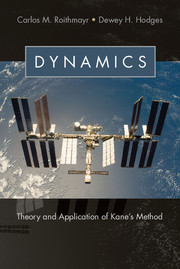Description
Dynamics
Theory and Application of Kane's Method
Authors: Roithmayr Carlos M., Hodges Dewey H.
This book presents Kane's method, a modern approach that leads economically to equations that can be readily solved by computer.
Language: English
Subject for Dynamics:
Approximative price 53.83 €
In Print (Delivery period: 14 days).
Add to cart
Publication date: 03-2016
536 p. · 22.1x28.6 cm · Hardback
536 p. · 22.1x28.6 cm · Hardback
Description
/li>Contents
/li>Biography
/li>
This book is ideal for teaching students in engineering or physics the skills necessary to analyze motions of complex mechanical systems such as spacecraft, robotic manipulators, and articulated scientific instruments. Kane's method, which emerged recently, reduces the labor needed to derive equations of motion and leads to equations that are simpler and more readily solved by computer, in comparison to earlier, classical approaches. Moreover, the method is highly systematic and thus easy to teach. This book is a revision of Dynamics: Theory and Applications (1985), by T. R. Kane and D. A. Levinson, and presents the method for forming equations of motion by constructing generalized active forces and generalized inertia forces. Important additional topics include approaches for dealing with finite rotation, an updated treatment of constraint forces and constraint torques, an extension of Kane's method to deal with a broader class of nonholonomic constraint equations, and other recent advances.
1. Differentiation of vectors; 2. Kinematics; 3. Constraints; 4. Mass distribution; 5. Generalized forces; 6. Constraint forces, constraint torques; 7. Energy functions; 8. Formulation of equations of motion; 9. Extraction of information from equations of motion; 10. Kinematics of orientation; Problem sets; Appendix I. Direction cosines as functions of orientation angles; Appendix II. Kinematical differential equations in terms of orientation angles; Appendix III. Inertia properties of uniform bodies; Index.
Carlos M. Roithmayr is a senior aerospace engineer in the Systems Analysis and Concepts Directorate at the NASA Langley Research Center in Hampton, Virginia. He earned a Bachelor of Aerospace Engineering degree at the Georgia Institute of Technology, both an M.S. and a Degree of Engineer in Aeronautics and Astronautics from Stanford University, and a Ph.D. in Aerospace Engineering from the Georgia Institute of Technology. He began his career with NASA at the Johnson Space Center in Houston, Texas. His research interests include dynamics of multibody mechanical systems, spacecraft attitude dynamics and control, and orbital mechanics, and he has contributed to a wide variety of Agency projects and missions. He is author or coauthor of numerous refereed journal papers. Dr Roithmayr is a senior member of the American Institute of Aeronautics and Astronautics.
Dewey H. Hodges is a professor of aerospace engineering at the Georgia Institute of Technology. He holds a B.S. in Aerospace Engineering from the University of Tennessee at Knoxville and both M.S. and Ph.D. degrees in Aeronautics and Astronautics from Stanford University. His research interests include aeroelasticity, structural mechanics, rotorcraft dynamics, finite element analysis, and computational optimal control. He has authored or coauthored five books and more than 200 technical papers in refereed journals. Professor Hodges is a Fellow of the American Helicopter Society, the American Institute of Aeronautics and Astronautics, the American Society of Mechanical Engineers, and the American Academy of Mechanics. He serves on the editorial boards of the Journal of Fluids and Structures, the Journal of Mechanics of Materials and Structures, and Nonlinear Dynamics.
Dewey H. Hodges is a professor of aerospace engineering at the Georgia Institute of Technology. He holds a B.S. in Aerospace Engineering from the University of Tennessee at Knoxville and both M.S. and Ph.D. degrees in Aeronautics and Astronautics from Stanford University. His research interests include aeroelasticity, structural mechanics, rotorcraft dynamics, finite element analysis, and computational optimal control. He has authored or coauthored five books and more than 200 technical papers in refereed journals. Professor Hodges is a Fellow of the American Helicopter Society, the American Institute of Aeronautics and Astronautics, the American Society of Mechanical Engineers, and the American Academy of Mechanics. He serves on the editorial boards of the Journal of Fluids and Structures, the Journal of Mechanics of Materials and Structures, and Nonlinear Dynamics.
© 2024 LAVOISIER S.A.S.




